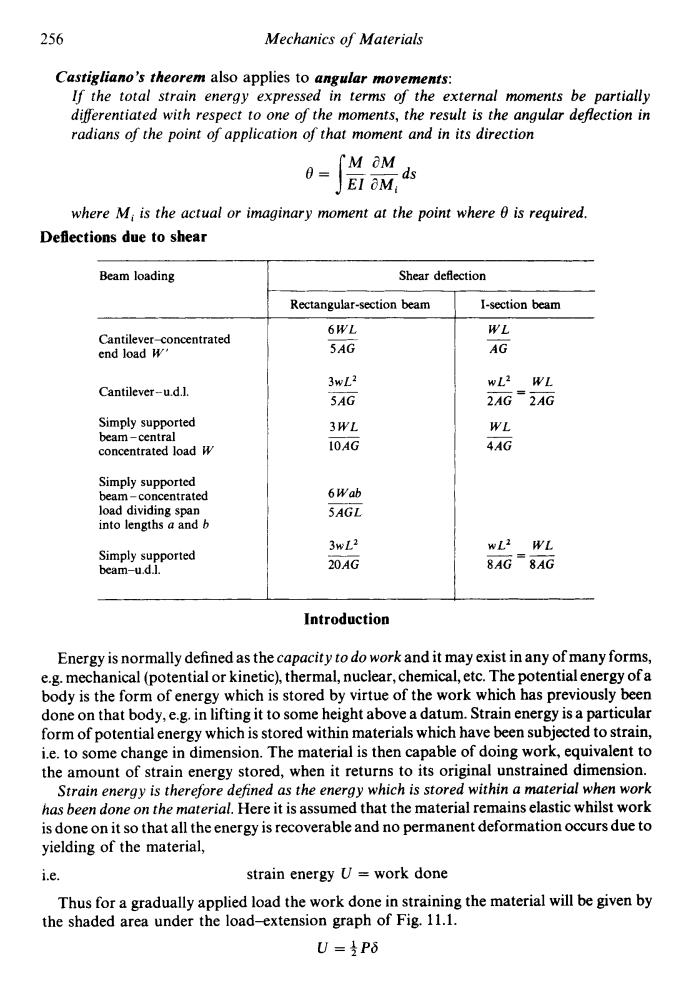正在加载图片...

256 Mechanics of Materials Castigliano's theorem also applies to angular movements: If the total strain energy expressed in terms of the external moments be partially differentiated with respect to one of the moments,the result is the angular deflection in radians of the point of application of that moment and in its direction 0-EI OM where M;is the actual or imaginary moment at the point where 0 is required. Defections due to shear Beam loading Shear deflection Rectangular-section beam I-section beam 6WL WL Cantilever-concentrated end load W' 5AG AG 3wL2 wL2 WL Cantilever-u.d.I. 5AG 2AG2AG Simply supported 3WL WL beam-central concentrated load W 10AG 4AG Simply supported beam-concentrated 6Wab load dividing span SAGL into lengths a and b 3wL2 wL2 WL Simply supported 8AG8AG beam-u.d.l. 20AG Introduction Energy is normally defined as the capacity to do work and it may exist in any of many forms, e.g.mechanical(potential or kinetic),thermal,nuclear,chemical,etc.The potential energy ofa body is the form of energy which is stored by virtue of the work which has previously been done on that body,e.g.in lifting it to some height above a datum.Strain energy is a particular form of potential energy which is stored within materials which have been subjected to strain, i.e.to some change in dimension.The material is then capable of doing work,equivalent to the amount of strain energy stored,when it returns to its original unstrained dimension. Strain energy is therefore defined as the energy which is stored within a material when work has been done on the material.Here it is assumed that the material remains elastic whilst work is done on it so that all the energy is recoverable and no permanent deformation occurs due to yielding of the material, i.e. strain energy U work done Thus for a gradually applied load the work done in straining the material will be given by the shaded area under the load-extension graph of Fig.11.1. U=Pδ256 Mechanics of Materials Beam loading Castigliano’s theorem also applies to angular movements: If the total strain energy expressed in terms of the external moments be partially diferentiated with respect to one of the moments, the result is the angular deflection in radians of the point of application of that moment and in its direction M 8M O= --d~ 1.1 aMi where Mi is the actual or imaginary moment at the point where 0 is required, Deflections due to shear Shear deflection Rectangular-section beam I-section beam 6 WL WL Cantileverxoncentrated end load W’ Cantilever-u.d.1. 3WLZ 5AG __ Simply supported 3WL beam -central concentrated load W Simply supported beam - concentrated load dividing span into lengths a and b Simply supported beam-u.d.1. 6 Wab 5AGL ~ wL2 WL 2AG ZAG Idlo WL 3wL2 20AG __ wL2 WL 8AG 8AG Introduction Energy is normally defined as the capacity to do work and it may exist in any of many forms, e.g. mechanical (potential or kinetic), thermal, nuclear, chemical, etc. The potential energy of a body is the form of energy which is stored by virtue of the work which has previously been done on that body, e.g. in lifting it to some height above a datum. Strain energy is a particular form of potential energy which is stored within materials which have been subjected to strain, i.e. to some change in dimension. The material is then capable of doing work, equivalent to the amount of strain energy stored, when it returns to its original unstrained dimension. Strain energy is therefore deJined as the energy which is stored within a material when work has been done on the material. Here it is assumed that the material remains elastic whilst work is done on it so that all the energy is recoverable and no permanent deformation occurs due to yielding of the material, i.e. strain energy U = work done the shaded area under the load-extension graph of Fig. 11.1. Thus for a gradually applied load the work done in straining the material will be given by U=iPG